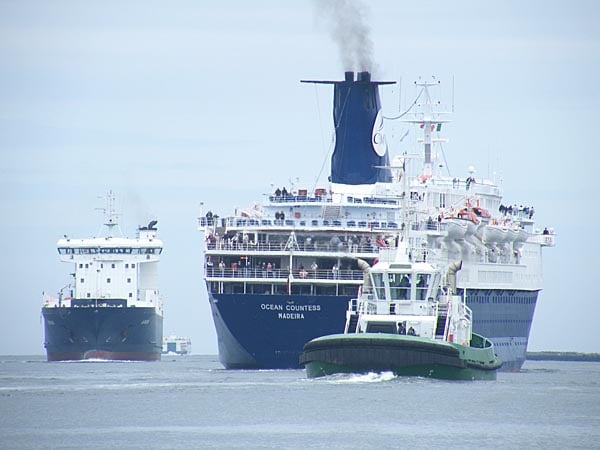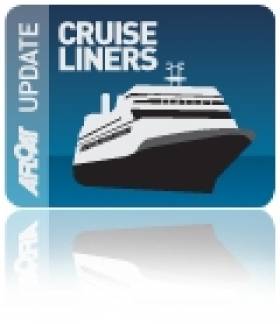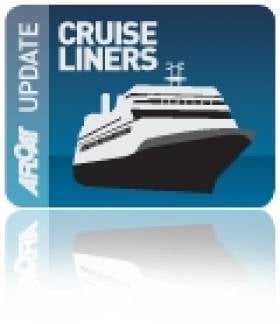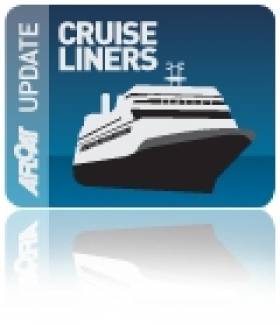Displaying items by tag: Cruise liner
Proposal to Move Cruise Ship Terminal on the Liffey
According to a report in the Irish Times this morning Dublin Port Company is considering a proposal by docklands entrepreneur Harry Crosbie to relocate the city's cruise ship terminal to a site closer to the heart of the city beside the East Link bridge. 86 Cruise liners arrived in Dublin Port this Summer.
Cruise liner traffic into Dublin is in line with last years figures when almost 80 cruise liners visited the port in 2009, carrying 120,000 passengers and crew to Dublin.
The largest arrival the blue hulled Marco Polo at 176 metre contribute significantly to the Dublin economy.
Dublin and Cork Share Cruise-Calls Bonanza
The ports of Dublin and Cork are scheduled to receive a record 139 cruiseships in total this year, bringing 180,000 visitors and crew. Many more of these cruiseships are due to visit over the next two months and stretching into late Autumn. Between €35-55m is expected to be generated into the Dublin region from high-spend cruise visitors
while a further €5m is predicted for the local economy at Cork, writes Jehan Ashmore.
A notable visitor due to grace Dublin Bay is the return of The World, albeit not strictly a cruiseship but the first custom-built time-share ship. The vessel is to dock in the capital for four-nights from 4-8 August and then sails overnight to Cobh, for two-nights from 9-11 August.
In essence, The World presents an exclusively unique lifestyle experience. Instead of passengers, there are 'residents' who live onboard. Residents of the 43,188 gross tonnes (GT) vessel don't merely occupy a cabin but own large-sized luxurously appointed private apartments that are 'home' complete with balconies.
On 9 August, Silver Cloud docks at Dublin from Oban, Scotland. Measuring 16,927 GT, the vessel may not be the largest with only 315 passengers, but is an ultra-luxury cruiseship, regarded as one of the highest standards in the cruise-sector industry.
Returning to Cork Harbour, Cobh awaits the mighty Independence of the Seas. At 154,407 tonnes, she is the biggest ever cruiseship to dock at any Irish port. With a massive 4,375 passenger capacity, attractions include rock-climbing or surfing-boarding using a special pool. The 'Independence' berths mid-afternoon on 29 August for an overnight call, departing 18.00hrs the next day.
Among smaller cruiseships, the private-motoryacht like, Island Sky of 4,000 tonnes and with 200 passengers, calls to Dublin on 11 August, and may berth upriver close to the new Samual Beckett Bridge.
Those keen on traditional ships, can look forward to the visit of Classic International Cruises Princess Danae, built in 1955. The veteran is due 16 August, and her sister, Princess Daphne is expected 2 September. Unusually the 16,000 tonnes pair were converted from general cargo-ships for a career in cruising.
New cruiseship, Costa Luminosa (92,700 GT) costing US $ 548m makes a second call to Cobh on 3 September and is operated by Costa Cruises.
This is the first time the Italian company has ventured into Irish cruising waters.
Without doubt the largest Dublin caller this season will be Emerald Princess. The giant weighs some 113,000 gross tonnes and at 288m long will certainly provide a spectacle, with lights blaring over a dozen or so decks, during a dusk departure on 14 September.
Also entering service this year, P&O Cruises 116,000 tonnes new Azura, is set to visit Dublin on 23 September and Cork the next day. The Italian built newbuild cost US $ 535m and has a capacity for 3,076 passengers.

Ocean Countess departing Dublin. Photo: Jehan Ashmore/ShipSNAPS
A newcomer to Irish ports is Cruise & Maritime Voyages Ocean Countess which is making round Ireland itineraries with calls at Cobh on 13 August and 12 September. Incidently the 'Countess' was converted into a troopship for the Falkland Islands conflict in 1982.
Jewel of the Seas (90,090 GT) makes a Cobh call on 7 September and exactly a month later returns, marking the last cruise-call to Cork in 2010 while Fred Olsen's Boudicca will be Dublin's last caller on 20 November.
For further information on other visiting cruiseships, please click links:
New Business Could Float in on the Tide
Local TD and Minister of Sport Mary Hanafin has given her support to Dun Laoghaire Harbour Company's initiative to promote the town as a cruise tourism destination on Dublin Bay. Writing in her latest newsletter to constituents this month, the Minister says she will do everything within her remit to support the bid.
Six Star Cruise Liner Arrives in Dublin Bay
A 670-foot cruise liner, one of the most luxurious in the world, arrived in Dublin Port this morning. The six star Seven Seas Voyager is the world's second all-suite, all-balcony ship and the second to feature a restaurant operated by Le Cordon Bleu of Paris, following sister ship Seven Seas Mariner. There are four main dining venues, surprising for a ship her size. The ship sailed from Belfast overnight. More details here.
Cruise Liner with Giant Lips Visits Dublin
A Cruise liner berthed on the river Liffey this morning will draw a smile from Dubliners because of the giant red lips and eyes painted on the ship. The Aida Aura is a 203m long vessel carries 1400 passengers and is operated by the German unit of P&O Cruises.
Expedition Liner Visits Cork and Dublin
An interesting visitor to Dublin Bay this morning is the MS Fram, a 500-passenger capacity cruise ship that has been designed with a reinforced hull for cruising arctic waters. The Norwegian ship cruised from Cork overnight. It has a four star rating from www.choosingcruising.co.uk and more details are here. MS Fram is operated by the Hurtigruten ASA Group. The ship made its first maiden voyage to Greenland in May 2007.
Three Cruise Liners Arrive in Dublin Port
Of the 86 Cruise liners due in to Dublin Port this Summer, three are docked in the Capital's port today, two arriving after 7am this morning.
Cruise liner traffic into Dublin is in line with last years figures when almost 80 cruise liners visited the port in 2009, carrying 120,000 passengers and crew to Dublin.
The 139 metre long Spirit of Adventure, the 163 metre Ocean Countess and the largest blue hulled Marco Polo at 176 metre contribute significantly to the Dublin economy.
The port company estimates that cruise liner visits generate in the region of €35 million to €50 million for Dublin’s economy.
Dublin is Ireland's most popular port with cruise liners. 75 visited Dublin in 2006, numbers have grown despite the down turn. Smaller liners can come up the River Liffey close to the city centre while the larger ships berth in Alexandra Quay, which is only 2 kms from the city centre.




































































